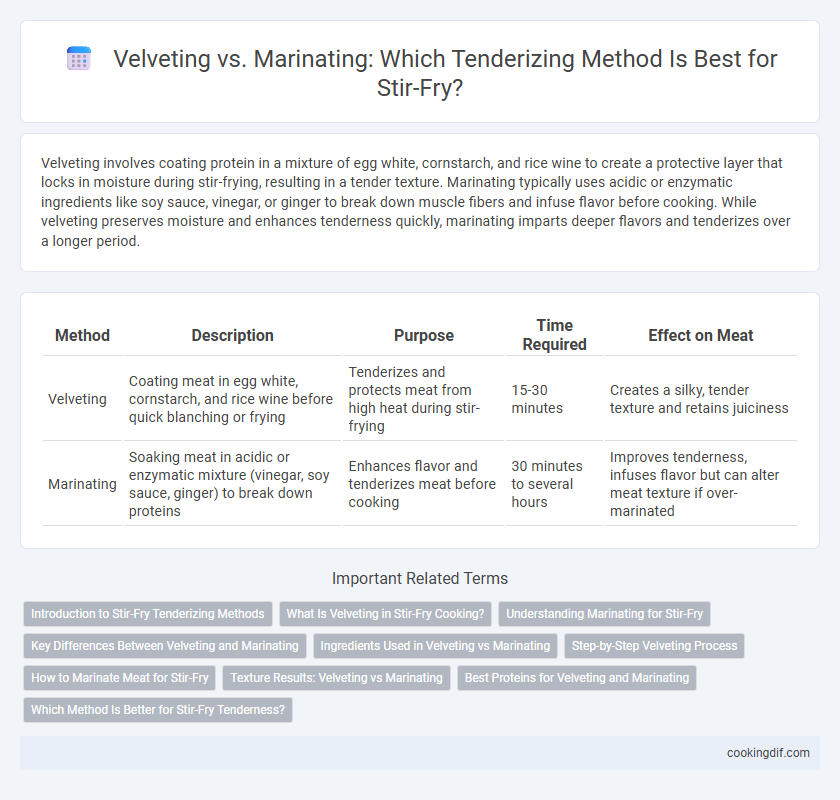Velveting involves coating protein in a mixture of egg white, cornstarch, and rice wine to create a protective layer that locks in moisture during stir-frying, resulting in a tender texture. Marinating typically uses acidic or enzymatic ingredients like soy sauce, vinegar, or ginger to break down muscle fibers and infuse flavor before cooking. While velveting preserves moisture and enhances tenderness quickly, marinating imparts deeper flavors and tenderizes over a longer period.
Table of Comparison
| Method | Description | Purpose | Time Required | Effect on Meat |
|---|---|---|---|---|
| Velveting | Coating meat in egg white, cornstarch, and rice wine before quick blanching or frying | Tenderizes and protects meat from high heat during stir-frying | 15-30 minutes | Creates a silky, tender texture and retains juiciness |
| Marinating | Soaking meat in acidic or enzymatic mixture (vinegar, soy sauce, ginger) to break down proteins | Enhances flavor and tenderizes meat before cooking | 30 minutes to several hours | Improves tenderness, infuses flavor but can alter meat texture if over-marinated |
Introduction to Stir-Fry Tenderizing Methods
Velveting and marinating are essential techniques for tenderizing stir-fry ingredients, each enhancing texture and flavor uniquely. Velveting involves coating meat in a mixture of egg white, cornstarch, and rice wine to create a protective barrier that locks in moisture during high-heat cooking. Marinating uses acidic or enzymatic ingredients like soy sauce, ginger, or pineapple to break down protein fibers, resulting in a more tender and flavorful stir-fry.
What Is Velveting in Stir-Fry Cooking?
Velveting in stir-fry cooking is a Chinese technique used to tenderize meat by coating it with a mixture of egg white, cornstarch, and rice wine or soy sauce before briefly blanching or frying. This method creates a protective layer that locks in moisture, resulting in a silky, tender texture different from the absorption process in marinating. Velveting is especially effective for delicate proteins like chicken, beef, or seafood, ensuring they remain juicy and flavorful during high-heat stir-frying.
Understanding Marinating for Stir-Fry
Marinating for stir-fry involves soaking meat in a seasoned liquid mixture, often containing soy sauce, rice wine, ginger, and garlic, to enhance flavor and tenderize fibers over time. The acidic components and enzymes in marinades break down muscle proteins, resulting in a more succulent texture compared to velveting, which relies on coating meat with cornstarch and egg white before cooking. Proper marinating time, typically 30 minutes to a few hours, ensures optimal absorption without compromising the meat's structural integrity in fast-cooked stir-fry dishes.
Key Differences Between Velveting and Marinating
Velveting tenderizes meat by coating it in a mixture of cornstarch, egg white, and rice wine or vinegar, creating a protective barrier that locks in moisture during high-heat stir-frying. Marinating involves soaking meat in acidic or enzymatic liquids such as soy sauce, vinegar, or citrus juice to break down muscle fibers and enhance flavor absorption over a longer period. While velveting results in a silky, tender texture ideal for quick cooking, marinating imparts deeper flavor penetration but requires more time to achieve tenderness.
Ingredients Used in Velveting vs Marinating
Velveting uses a mixture of cornstarch, egg whites, and rice wine or vinegar to create a protective coating that locks in moisture and enhances tenderness during stir-frying. Marinating incorporates acidic ingredients such as soy sauce, citrus juice, or vinegar combined with aromatics like garlic and ginger to penetrate and break down muscle fibers. The choice between velveting and marinating depends on desired texture and flavor infusion, with velveting focusing on a silky surface and marinating emphasizing deeper seasoning.
Step-by-Step Velveting Process
Velveting involves coating bite-sized meat pieces in a mixture of egg white, cornstarch, and rice wine or soy sauce, then briefly blanching or deep-frying them to lock in moisture and create a velvety texture. The process starts by mixing these ingredients into a smooth batter, followed by evenly tossing the meat to ensure a delicate protective layer forms. After velveting, the meat remains tender and juicy when stir-fried at high heat, preventing the tough chewiness often caused by direct cooking.
How to Marinate Meat for Stir-Fry
To marinate meat for stir-fry, combine soy sauce, rice wine, cornstarch, and a small amount of oil to create a tenderizing mixture that locks in moisture and enhances flavor. Allow the meat to soak in the marinade for at least 15-30 minutes, or up to several hours for tougher cuts, ensuring the proteins absorb the seasoning and break down slightly. Proper marination results in a juicy, flavorful stir-fry with tender meat that cooks evenly and retains its texture.
Texture Results: Velveting vs Marinating
Velveting creates a silky, smooth texture by coating meat in a cornstarch and egg white mixture before briefly blanching it, preserving moisture and tenderness during stir-frying. Marinating infuses flavor but can slightly firm the meat due to acidic ingredients breaking down proteins over time. Velveting provides a consistently tender bite ideal for quick, high-heat cooking, while marinating enhances taste with variable effects on texture depending on ingredients and duration.
Best Proteins for Velveting and Marinating
Velveting is best suited for delicate proteins such as chicken breast, shrimp, and fish fillets, as it helps retain moisture and tenderness during high-heat stir-frying. Marinating enhances flavor and tenderizes tougher cuts like beef flank or pork shoulder by breaking down muscle fibers with acidic ingredients like soy sauce, vinegar, or citrus juice. Choosing the right protein and tenderizing method impacts texture and taste, ensuring a perfect stir-fry outcome.
Which Method Is Better for Stir-Fry Tenderness?
Velveting uses a cornstarch and egg white coating to create a protective barrier that seals in moisture during stir-frying, resulting in a tender, silky texture. Marinating relies on acidic or enzymatic ingredients like soy sauce, rice wine, or ginger to break down proteins, infusing flavor and enhancing tenderness over time. For optimal stir-fry tenderness, velveting is often more effective due to its quick moisture retention and smooth finish, while marinating excels in flavor development but may require longer preparation.
Velveting vs Marinating for tenderizing Infographic

 cookingdif.com
cookingdif.com